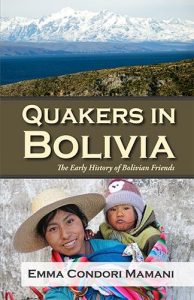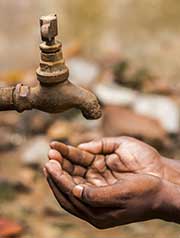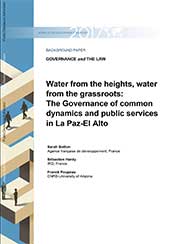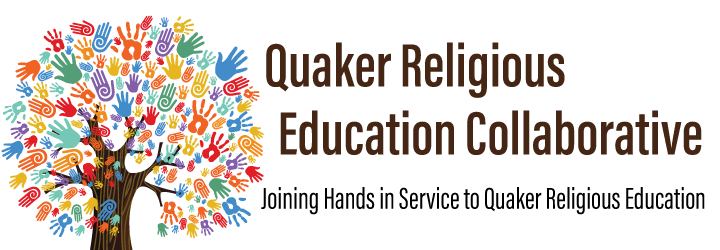
In 2016, when global warming left the entire city of La Paz without drinking water for weeks, the Friends International Bilingual Center (FIBC) seized the teachable moment to educate children about the crisis and what they could do to help. Through QREC, Friends in the US who learned about the situation, developed lessons on the Bolivian water crisis, the response of young Friends and the value of simplicity, stewardship and global community. First Day School classes in Nashville Tennessee and Madison Wisconsin hosted fundraisers to educate their monthly meetings and support the FIBC children’s program. Youth in Bolivia and the US connected in a video conversation facilitated by FIBC interpreters.
See below for a lesson plan, presentation and background reports For further information contact Emma Condori-Mamani: centrobilingueamigos7bo@gmail.com.
![]() Download/View the Lesson Plan here.
Download/View the Lesson Plan here.
![]() Download/View the Presentation here.
Download/View the Presentation here.
More Resources
 Quakers in Bolivia: The Early History of Bolivian Friends takes us back to a century ago when the Quaker community started in Bolivia. Emma Condori Mamani shows the life of the pioneer missionaries in the lands where protestant Christians were hated, mistreated, and sometimes punished. This remarkable history brings the holiness, sacrifice, and dedication of the Quaker missionaries and Bolivian founders alive as inspiration to us in our lives today. Then the author brings our understanding up to contemporary times by describing her personal story of growing up a Friend in Bolivia.
Quakers in Bolivia: The Early History of Bolivian Friends takes us back to a century ago when the Quaker community started in Bolivia. Emma Condori Mamani shows the life of the pioneer missionaries in the lands where protestant Christians were hated, mistreated, and sometimes punished. This remarkable history brings the holiness, sacrifice, and dedication of the Quaker missionaries and Bolivian founders alive as inspiration to us in our lives today. Then the author brings our understanding up to contemporary times by describing her personal story of growing up a Friend in Bolivia.
 World Bank Study Proposes Solutions to Bolivia’s Water Crisis (Holly Davison, 23 March 2017, Columbia University Earth Institute). Bolivia is currently in the midst of the worst drought in twenty-five years following decades of intense water crises, including an infamous “water war” in 2000 in the city of Cochabamba in which tens of thousands of Bolivians protested the privatization of water. read more…
World Bank Study Proposes Solutions to Bolivia’s Water Crisis (Holly Davison, 23 March 2017, Columbia University Earth Institute). Bolivia is currently in the midst of the worst drought in twenty-five years following decades of intense water crises, including an infamous “water war” in 2000 in the city of Cochabamba in which tens of thousands of Bolivians protested the privatization of water. read more…
 Water from the heights, water from the grassroots: The Governance of common dynamics and public services in La Paz-El Alto (Sarah Botton, Agence française de développement, France; Sébastien Hardy, IRD, France; Franck Poupeau, CNRS-University of Arizona). El Alto and La Paz are adjacent sister communities supplied by different water systems, but the inequalities in infrastructure between the two areas lie in their differing respective economic potential. Due to their histories, the two cities present distinct but equally marked forms of socio-spatial segregation. Unsurprisingly, the best equipped neighborhoods are both the oldest and the wealthiest. Meanwhile, the middle classes (middle managers, employees, and members of the intellectual professions) tend to live in the neighborhoods surrounding the historic center. The central area of the city encompasses the business district and the government administrations; it is surrounded by the laderas—neighborhoods set on the mountain slopes extending as far as the high plateau—with their brick or adobe residential buildings. El Alto, on the other hand, has a different but no less rigid layout. It is articulated around La Ceja, the main road junction with La Paz. The city’s inner ring is made up of the oldest and most compact neighborhoods and includes administrative buildings and small artisanal and commercial enterprises. A third ring, less densely urbanized and more extensive, is the product of the endogenous growth of the two cities and of the trend for families to purchase property in less expensive areas on which they can build their own houses. The farther neighborhoods are from the first ring of development, the worse their access to urban services.
Water from the heights, water from the grassroots: The Governance of common dynamics and public services in La Paz-El Alto (Sarah Botton, Agence française de développement, France; Sébastien Hardy, IRD, France; Franck Poupeau, CNRS-University of Arizona). El Alto and La Paz are adjacent sister communities supplied by different water systems, but the inequalities in infrastructure between the two areas lie in their differing respective economic potential. Due to their histories, the two cities present distinct but equally marked forms of socio-spatial segregation. Unsurprisingly, the best equipped neighborhoods are both the oldest and the wealthiest. Meanwhile, the middle classes (middle managers, employees, and members of the intellectual professions) tend to live in the neighborhoods surrounding the historic center. The central area of the city encompasses the business district and the government administrations; it is surrounded by the laderas—neighborhoods set on the mountain slopes extending as far as the high plateau—with their brick or adobe residential buildings. El Alto, on the other hand, has a different but no less rigid layout. It is articulated around La Ceja, the main road junction with La Paz. The city’s inner ring is made up of the oldest and most compact neighborhoods and includes administrative buildings and small artisanal and commercial enterprises. A third ring, less densely urbanized and more extensive, is the product of the endogenous growth of the two cities and of the trend for families to purchase property in less expensive areas on which they can build their own houses. The farther neighborhoods are from the first ring of development, the worse their access to urban services.
Author: Emma Condori-Mamani, Sita Diehl
Illustrator:
Publisher: QREC
Age Group: 13 to 15 years, 6 to 8 years, 9 to 12 years
Preparation Time: 1.00
Related File: Click to view/download file
Related Link (or File): Click to go to link
Topics: Community, Peace, Service, Service Projects, Sharing, Simplicity, Social Action, Stewardship, Truth



